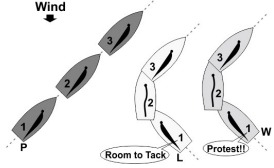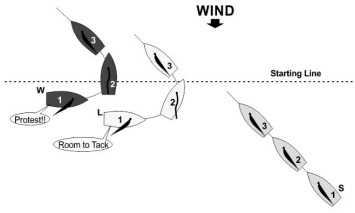
| Facts for Question 1: |
|---|
| L and W are close-hauled on starboard tack. L is on a collision course with P, a boat racing, close-hauled on port tack. L hails ‘Room to tack’. W responds and protests. |
| Rules |
|---|
| Rule 20, Room to Tack at an Obstruction |
| Summary: |
|---|
| If a boat hails 'Room to tack' when she is neither approaching an obstruction nor sailing close-hauled or above, she breaks rule 20.1. The hailed boat is required to respond even if the hail breaks rule 20.1. |

| Facts for Question 1: |
|---|
| L and W are close-hauled on starboard tack. L is on a collision course with P, a boat racing, close-hauled on port tack. L hails ‘Room to tack’. W responds and protests. |
| Question 1: |
|---|
| How does rule 20 apply to this situation? |
| Answer 1: |
|---|
|
Although there is risk of collision between L and P, P is not an obstruction to L and W because neither L nor W is required to keep clear of her. At the time L hails for room to tack, she is not approaching an obstruction and she breaks rule 20.1(a). Rule 20.2(b) requires W to respond to L's hail even if the requirements of rule 20.1 are not met. Therefore, W must either tack as soon as possible or hail 'You tack' and then give room for L to tack and avoid her. When W responds, L must tack as soon as possible. W responds by tacking and breaks no rule. |

| Facts for Question 2: |
|---|
| L and W are reaching along the starting line on port tack. L is on a collision course with S, approaching the line close-hauled on starboard tack. L hails ‘Room to tack’. W responds and protests. |
| Question 2: |
|---|
| How does rule 20 apply to this situation? |
| Answer 2: |
|---|
|
S is an obstruction to both W and L. At the time L hails for room to tack, she is approaching an obstruction and will need to make a substantial course change to avoid it. However, because she is not sailing close-hauled or above, she breaks rule 20.1(b). As in Answer 1, rule 20.2(b) requires W to respond to the hail even if the requirements of rule 20.1 are not met. Therefore, W must either tack as soon as possible or hail 'You tack' and then give room for L to tack and avoid her. W responds by tacking and breaks no rule. If L fails to tack, and for example sails astern of S, she also breaks rule 20.2(d). |